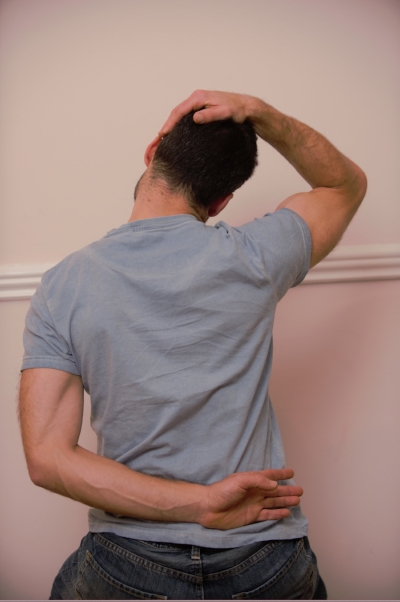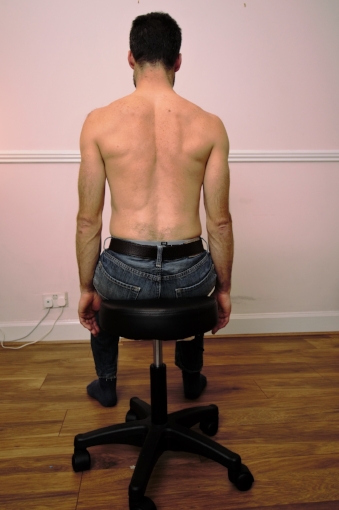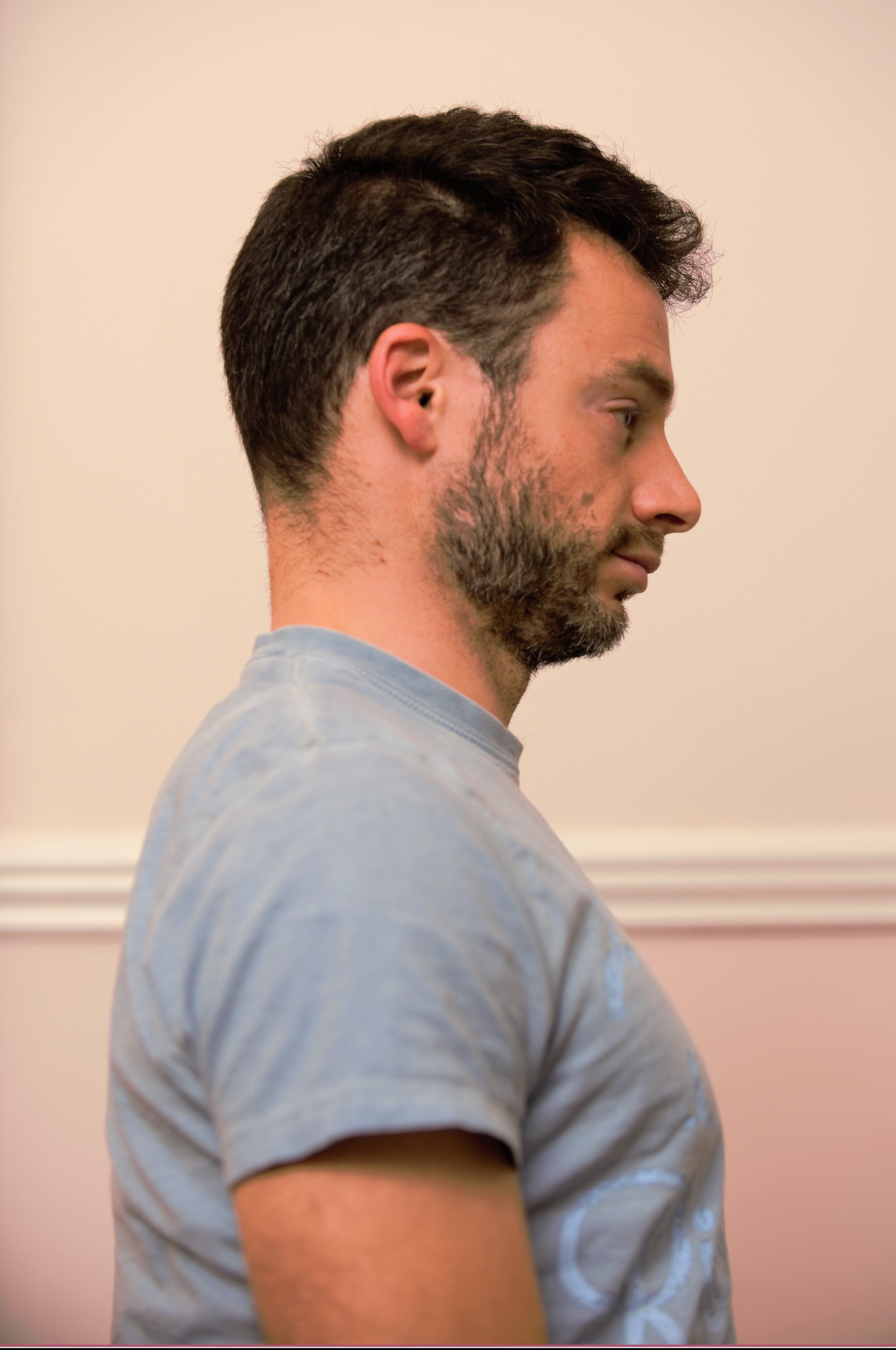The Problems with Sitting...
I was at a programming conference last month providing seated chair massage to alleviate aches and pains in necks/backs/shoulders and to give people a bit of relaxation time. Almost all of the people taking up the offer of massage pointed in between their shoulder blades, to the tops of their shoulders, or their necks and complained of pain. As I looked around the room, this was a common sight...
Recognise this in yourself? Do you often find yourself sitting slumped with bad posture in front of a laptop or a computer? When sitting like this for any length of time, your body starts to change. Your shoulders round forward, the pectoral muscles in your chest become short and tight. Opposing muscles in your back, in between your shoulder blades become taut and stretched and can't work as effectively. Hip flexors tighten up and muscles such as your gluteus maximus get lazy and sluggish, putting the muscles in your lower back under strain. Not only that, it can cause all sorts of other physiological effects. This animation summarises it better than I can.
We are not designed to be sitting at a desk for hours on end. You can easily spend 8 hours a day at a desk. If you commute by car, bus or train, add more time sitting. If you go home and slump in front of the TV in the evening, that's even longer just sitting around. Our bodies just don't like doing it. If this all sounds very familiar, there are some things that you can do to help ease the aches and pains.
One of the most important things that you can do is to move around more often. Set an alarm on your phone or your computer, get up every hour and walk around, have a stretch, shrug your shoulders up and down and roll them forwards and backwards, rotate your neck around, run up and down the stairs a couple of times, do a few squats, jump up and down on the spot.... you get the idea, just move! It will get the blood circulating properly again, wake up those lazy muscles, stretch out the bits that have got tight. It might sound a little bit impractical but building a couple of minutes of movement into your day every hour will start to make you feel much better.
The next most important thing that you can do is ensure that you are sitting correctly and comfortably, minimising the strain on your body. If you use a laptop, watch this short animation to give you ideas about how to help set yourself up better.
For using a PC, this guide from BackCare is useful as it tells you the best way to set up your desk and equipment. A lot of people don't realise that if you use DSE (Display Screen Equipment) for a large part of your day, your employers must
- analyse workstations to assess and reduce risks
- make sure controls are in place
- provide information and training
- provide eye and eyesight tests on request, and special spectacles if needed
- review the assessment when the user or DSE changes.
See the Health and Safety Executive guide for more information. Don't be scared to approach your line manager or H&S department to request a DSE assessment and if you need special equipment such as lumbar support or foot rests, they can source those for you.
If you drive for a living or spend a long time commuting, don't neglect your car - this guide will help you look at how you set up your car seat and give you tips on a comfortable driving position.
Now that you are set up properly when sitting, and you are moving more often, you can also try some stretches and strengthening exercises.
STRETCHES
1. Lying Chest Stretch
- Roll up a towel or pillow and place on floor
- Lie down, placing upper back over the towel
- Relax over the towel, allowing arms to open and feel the stretch across the chest
- Adjust position of arms to change where you feel the stretch if you need to
- Chill out there for a while and allow the muscles to relax
2. Doorway Stretch
- Using a doorway, place both your arms against the walls on each side of the door
- Shoulders and elbows should be at 90 degrees
- Step through the doorway with one leg so your arms are drawn back, or keeping your body straight, lean forward, and you should feel a stretch through the front of your shoulders and chest
- Raise or lower the elbows to change to focus of the stretch on the muscle fibres in the pecs as they run at different angles. You can also stretch one side at a time.
- Hold for 20-30 seconds, repeat 2-3 times
- A similar stretch can be done using the walls in the corner of a room
3. Upper Trapezius Stretch
- Sit upright and tall on a chair, with your shoulders back.
- Reach one arm behind your back and use the other arm to gently pull your head to the opposite side as if you are trying to bring your ear to your shoulder. Keep your chin level and head back.
- Once you feel a comfortable stretch, hold for 20-30 seconds. Repeat both side 2-3 times each.
4. Levator Scapula Stretch
- This stretch is more focused on the back of the neck.
- Sit upright and tall on a chair, with your shoulders back.
- Reach one arm behind your back as if you are trying to reach in between your shoulder blades.
- From here, rotate your head to the opposite side, then using your free hand, place it on the back of your head and pull down gently as if you are looking down toward your hip.
- Hold 20-30 seconds. Repeat both sides 2-3 times each.
STRENGTHENING EXERCISES
1. Posture Correction - Shoulder Position
- Sit on the edge of a chair and make sure that your spine is in a good comfortable position and your feet are flat on the floor
- Engage your abdominals with your arms relaxed at your sides
- First, think about drawing your shoulder blades down your back, making sure your shoulders are relaxed and not up by your ears
- Then, gently squeeze your shoulder blades together, using the muscles in between them
- Breathing deeply, hold for around 30 seconds
- Repeat 3-4 times
2. Posture Correction - Neck Position
- Sit in a relaxed position with head upright and shoulders back
- Keep your chin level, eyes forward, and draw your chin in towards your neck (a chin tuck), the motion might give you a double chin
- Try to keep the head level, don't tilt it up or down, think about keeping the length in the back of your neck
- Hold for 10 seconds, repeat 10 times
3. Wall Slides
- Keep your back and shoulders against the wall, you may need to step your feet forward a little
- Set your shoulder blades back and down
- Place your arms against the wall in a Y shape, palms facing outwards. If the arms don't lie against the wall, widen the Y shape. Keep your shoulders relaxed
- Engage the abdominal muscles
- Keeping the arms against the wall and shoulders relaxed, slide the arms into a W shape, squeezing the shoulder blades down and back
- Slide the arms back up into a Y shape, again keeping shoulders relaxed and down
- Repeat a few times (try 3 sets of 10), keeping the movements slow and controlled
- Stay in the range of motion that allows you to keep contact with the wall and build up to a full range of motion if not possible to start with
There are many other stretches and strengthening exercises but these are really good starting points for upper back, neck and shoulder pain.
If you are still experiencing issues, then a sports massage/soft tissue therapist can assess your posture and movement patterns, help to release shortened tight muscles, areas of tension and trigger points to give relief from the pain. A massage may sort your issues in one session, however for long standing chronic pain issues you may need more sessions. It is also important to say that massage is much more effective as part of a more complete package of change - changing your workstation, changing your posture, changing your habits and ensuring you move around more often and doing those stretches and strengthening exercises.
If you want more information on this blog, want to know how a soft tissue therapy treatment can help you, or want to book in for a massage, contact info@vssportsmassage.com or 07527154675.












